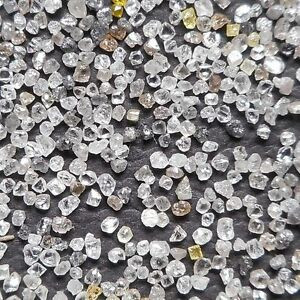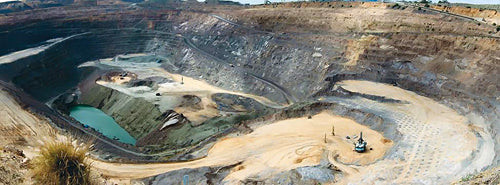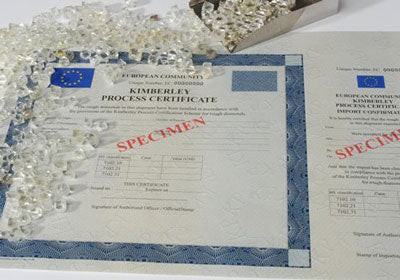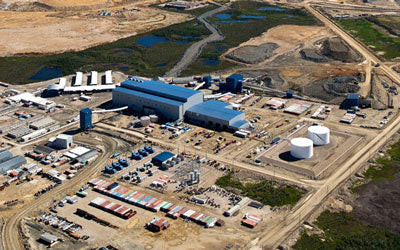Every year, the global diamond market sees a staggering exchange of approximately 133 million carats. Of these precious stones, around 30% are destined for the jewelry industry, where they symbolize enduring love, commitment, and timeless beauty. The remaining 70% are crucial for various industrial applications, highlighting the multifaceted importance of diamonds. Collectively, the diamond industry supports livelihoods for an estimated 10 million people worldwide.
 Rough Diamond Production
Rough Diamond Production
Diamonds are undeniably significant in both our personal lives and the broader global economy. But the question remains: Where To Find Diamonds? Let’s embark on a journey to uncover the origins of these coveted gemstones, exploring their geological formation, the countries rich in diamond reserves, and the intricate processes involved in bringing them to light.
The Deep Earth Genesis: How Diamonds Are Formed
The foundational element of diamonds is carbon, a ubiquitous substance found throughout our planet. Carbon exists in the atmosphere, oceans, within rocks, soil, and even in living organisms. However, the transformation of ordinary carbon into extraordinary diamonds requires very specific conditions of intense heat and pressure, conditions that are not commonly found.
The diamond’s birthplace is deep within the Earth’s mantle, approximately 160 kilometers (or about 100 miles) beneath the surface. This layer of the Earth is a realm of solid rock, abundant in magnesium, iron, and, crucially, carbon. Below the mantle lies the Earth’s core, composed of molten metals, generating immense heat that elevates the mantle’s temperature to well over 1,000 degrees Celsius (1,832 degrees Fahrenheit). This extreme heat enables carbon atoms to form robust chemical bonds with each other.
Once these carbon atoms are bonded, an extraordinary pressure of about 50 kilograms per square centimeter (around 725 pounds per square inch) is required to compress them into the crystalline structure that defines a diamond. These conditions of heat and pressure are typically associated with cataclysmic geological events, such as the movement of tectonic plates and meteorite impacts, events that predominantly occurred millions or even billions of years ago in Earth’s history.
After their formation deep within the Earth, diamonds remain embedded in rock formations until volcanic activity acts as a geological elevator, bringing them closer to the Earth’s surface. These volcanic eruptions, specifically those of a rare type called kimberlite and lamproite eruptions, are the primary mechanism by which diamonds are transported from the mantle to locations accessible for mining.
Global Diamond Hotspots: Countries with Significant Diamond Reserves
Diamonds have been discovered in over 30 countries across both the Northern and Southern Hemispheres, indicating a widespread, though not uniform, distribution across the globe. However, a select group of about 10 countries are distinguished by the substantial volume of diamonds they produce. These nations are the primary sources for the world’s diamond supply. Here’s a breakdown of the top diamond-producing countries by volume:
- Russia: Leading the world in diamond production, Russia mines an estimated 38 million carats annually. Note: Geopolitical events, such as the war in Ukraine, have impacted Russia’s diamond production and export capabilities.
- Botswana: A significant contributor, Botswana produces approximately 23 million carats of diamonds each year, with diamond mining being a cornerstone of its economy.
- Democratic Republic of Congo: The DRC yields around 16 million carats of diamonds annually, although a significant portion is from artisanal and small-scale mining operations.
- Australia: With a diverse geological landscape, Australia produces about 12 million carats of diamonds per year, including rare colored diamonds like pink and yellow diamonds from the Argyle mine (now closed).
- Canada: Known for its high-quality diamonds, Canada mines approximately 11 million carats annually, with mines located in its northern territories.
- Zimbabwe: Zimbabwe’s diamond production is around 10 million carats per year, primarily from the controversial Marange diamond fields.
- Angola: Angola contributes about 9 million carats of diamonds annually, with efforts to increase transparency and ethical sourcing in its diamond sector.
- South Africa: Historically significant in diamond mining, South Africa currently produces around 8 million carats per year.
- Namibia: Namibia’s diamond production is relatively lower in volume at around 2 million carats, but its diamonds are highly valued due to their exceptional quality and are often mined from marine deposits.
- Sierra Leone: While producing a smaller volume of about 609,000 carats annually, Sierra Leone’s diamonds are notable for their high per-carat value.
 Diamond production by country
Diamond production by country
Interestingly, when ranking these diamond-producing countries by the value of their diamonds per carat, the list shifts, demonstrating that volume doesn’t always equate to value:
- Namibia: US$805.00 per carat – Renowned for high-quality marine diamonds.
- Sierra Leone: US$302.00 per carat – Known for producing larger, gem-quality diamonds.
- Canada: US$180.00 per carat – Celebrated for their clarity and ethical sourcing.
- Botswana: US$156.00 per carat – Consistent producer of good quality diamonds.
- South Africa: US$145.00 per carat – Historical significance and diverse diamond types.
- Angola: US$136.00 per carat – Increasing focus on quality and value addition.
- Russia: US$ 82.00 per carat – Massive volume, but average per-carat value is lower compared to others.
- Zimbabwe: US$51.00 per carat – Lower value due to factors like diamond characteristics and market perception.
- Australia: US$32.00 per carat – Bulk of production is industrial grade, impacting average value.
- Democratic Republic of Congo: US$8.00 per carat – Predominantly industrial diamonds and artisanal mining.
This value-based ranking underscores that while some countries produce vast quantities of diamonds, others specialize in yielding fewer, but significantly more valuable, gemstones that are highly sought after for the jewelry market. Higher value typically correlates with gem-quality diamonds destined for jewelry, while lower value diamonds often find applications in industry due to their physical properties.
A Historical Glimpse: The Origins of Diamond Mining
The history of diamond mining is rich and spans millennia. Evidence suggests that diamond discovery and trade began in India as early as the 4th century BC. Villagers in ancient India would find diamonds in riverbeds and utilize them for trade and potentially ornamental purposes. For centuries, India remained the world’s sole known source of diamonds, holding a monopoly until the 1700s.
 Brazil Diamond Mining
Brazil Diamond Mining
The 18th century marked a turning point when diamonds were discovered in Brazil. During Brazil’s gold rush, miners panning rivers for gold stumbled upon diamonds. These Brazilian diamonds rapidly gained popularity, particularly among European ruling classes, and Brazil dominated the global diamond market for approximately 150 years.
By the mid-19th century, Brazilian diamond sources began to dwindle. Simultaneously, in 1867, a young boy named Erasmus Jacobs made a groundbreaking discovery in South Africa. He found a diamond along the Orange River on his father’s farm. The Jacobs family continued to find more diamonds in the area. Soon after, diamonds were also found scattered on the surface soil of nearby lands. Within two years of Erasmus’s initial find, diamond prospectors in South Africa realized that the bedrock beneath the topsoil also contained diamonds.
The period between 1870 and 1890 witnessed the rapid development of diamond mining towns in South Africa’s Cape Colony. Miners toiled relentlessly, breaking and crushing bedrock to extract diamonds. This era marked the formal commencement of large-scale diamond mining as an organized industry.
Modern Diamond Mining: Techniques and Processes
The modern diamond mining process is a complex operation that begins with prospecting. Diamond prospectors traverse the globe, analyzing soil samples to identify indicator minerals and rock types often associated with diamond deposits. They also search for secondary diamond sources, which can lead them back to primary deposits. Once a viable diamond deposit is located, mining operations commence.
Diamond deposits are primarily terrestrial, found on land, but significant deposits also exist on the ocean floor, particularly off the coast of Namibia. Regardless of the location, the scale of diamond mining is immense. On average, approximately 250 tonnes of earth – soil, sand, and rock – must be extracted, processed, and refined to yield just a single carat of rough diamond.
Contemporary diamond mines are highly mechanized. Controlled explosions are used to fracture layers of earth and rock, sometimes reaching depths exceeding 600 meters (almost 2000 feet). Heavy machinery, including tractors and trucks, then transport the excavated material to processing plants. Within these plants, conveyor belts carry the material through a series of machines designed to separate and extract diamonds. These machines utilize various techniques based on diamond’s unique physical properties, such as density and resistance to abrasion.
 Modern diamond mine
Modern diamond mine
However, not all diamond mining is technologically advanced. In certain regions, particularly in parts of Africa, artisanal and small-scale mining persists. Local communities, often using rudimentary tools and techniques passed down through generations, manually dig, crush rock, and sift through sediment to find diamonds. These operations, while less efficient, provide livelihoods for many families in these areas.
Ethical Considerations: Blood Diamonds and Responsible Sourcing
The diamond industry, while economically significant, has faced ethical challenges, most notably concerning “blood diamonds” or “conflict diamonds.” In the 1990s, in several African countries, including Sierra Leone, the Democratic Republic of Congo, and Angola, tribal wars and political instability created a context where armed groups seized control of diamond mines.
These groups exploited local populations, forcing them into slave labor in diamond mines. The diamonds extracted under these brutal conditions were then sold to finance conflicts and political agendas, leading to immense human suffering. Miners, including men, women, and children, endured inhumane conditions without basic necessities like food, clothing, medical care, or education.
 Blood diamond
Blood diamond
In response to the blood diamond crisis, the World Diamond Congress in Antwerp in July 2000 took decisive action. They passed a resolution to establish an international certification system to regulate the trade of rough diamonds and prevent blood diamonds from entering legitimate markets. This led to the creation of the Kimberley Process Certification Scheme (KPCS).
The Kimberley Process, established in 2003, is a joint initiative involving governments, the diamond industry, and civil society. It mandates that signatory countries implement strict controls over the export and import of rough diamonds, certifying that they are conflict-free. The KPCS tracks diamonds from mine to market, aiming to ensure that diamond revenues do not fund violence.
 Kimberley process certificate
Kimberley process certificate
Thanks to the Kimberley Process and growing consumer awareness, the vast majority of diamonds traded today are considered ethical diamonds, sourced from mines that adhere to responsible practices, prioritize worker safety, and contribute to community development. Consumers are increasingly seeking assurances that their diamonds are ethically sourced, driving demand for transparency and accountability in the diamond industry.
Leading the Way: Ethical Diamond Mining Companies
The global diamond market is served by numerous mining companies, varying in scale, production volume, and mining methods. Some companies focus on specific mine types, while others operate across diverse geological settings and mining environments. Here’s a closer look at three of the world’s leading ethical diamond mining companies:
- De Beers Group: As the world’s largest diamond mining company, De Beers controls approximately 35% of the global rough diamond supply. De Beers operates a wide array of mines, including open pit, underground, and marine operations, across countries like Botswana, South Africa, and Canada. Beyond mining, De Beers also has a significant presence in diamond retail and is famously known for its iconic slogan “A Diamond is Forever,” coined in 1947.
 De Beers Mine
De Beers Mine
- Alrosa: This Russian diamond mining company concentrates its operations on around 30 diamond deposits in Russia, with some activities in Africa. Alrosa accounts for approximately 27% of global rough diamond production and is particularly known for discovering pink diamonds, including a remarkable 25.68-carat pink diamond.
- Rio Tinto: Rio Tinto is a multinational corporation with diversified mining interests, including diamonds, metals, and minerals. Rio Tinto operates three diamond mines in Australia (Argyle – now closed), Canada (Diavik), and Zimbabwe (Murowa), contributing around 20% of the world’s rough diamond supply.
These leading diamond mining companies often have complex ownership structures, with joint ownership between private entities and government stakeholders. For example, De Beers is majority-owned by Anglo American plc (85%), with the government of Botswana holding a 15% share. Smaller, country-specific diamond mining companies, like Endiama in Angola, are also significant players.
Value Addition at Origin: Diamond Cutting and Polishing
Historically, rough diamonds were often exported from their countries of origin to be cut and polished in global diamond centers like Antwerp, Tel Aviv, and New York. Under this system, diamond-producing countries received limited economic benefit beyond the initial extraction. Recognizing this, many diamond-producing nations now mandate that a percentage of rough diamonds be processed within the country before export.
This shift aims to increase local value addition, create employment opportunities, and boost economic development in diamond-producing regions. Companies like De Beers are actively supporting this trend, supplying rough diamonds to local cutting and polishing businesses in mining countries.
The diamond cutting process is a meticulous craft that can take several months for a single stone. It involves:
- Planning: Carefully analyzing each rough diamond to determine the optimal cutting strategy to maximize its beauty and value.
- Cleaving or Sawing: Dividing larger diamond crystals into smaller, more manageable pieces.
- Bruting (Girdling): Shaping the diamond’s outline to create a rounded or specific shape, laying the foundation for the final cut.
- Polishing: Faceting and polishing the diamond to create smooth, light-reflective surfaces and remove imperfections.
- Evaluation: Assessing the cut, clarity, color, and carat weight to determine the diamond’s final value and quality.
 diamond polishing
diamond polishing
Once cut and polished, diamonds are ready for sale to jewelry manufacturers, retailers, and diamond brokers. Companies like Beldiamond work directly with clients to assist them in finding the ideal diamond and creating custom jewelry pieces, including engagement and wedding rings.
In conclusion, where to find diamonds is a question with multifaceted answers. Geologically, diamonds are found deep within the Earth’s mantle, brought to the surface by volcanic activity. Geographically, key diamond sources are concentrated in countries like Russia, Botswana, Canada, and South Africa, among others. Ethically, finding diamonds today increasingly means seeking out ethically sourced stones from companies committed to responsible mining practices and community development. The journey of a diamond, from its hidden origins to a sparkling gem, is a remarkable testament to geological forces, human ingenuity, and evolving ethical considerations within the diamond industry.

